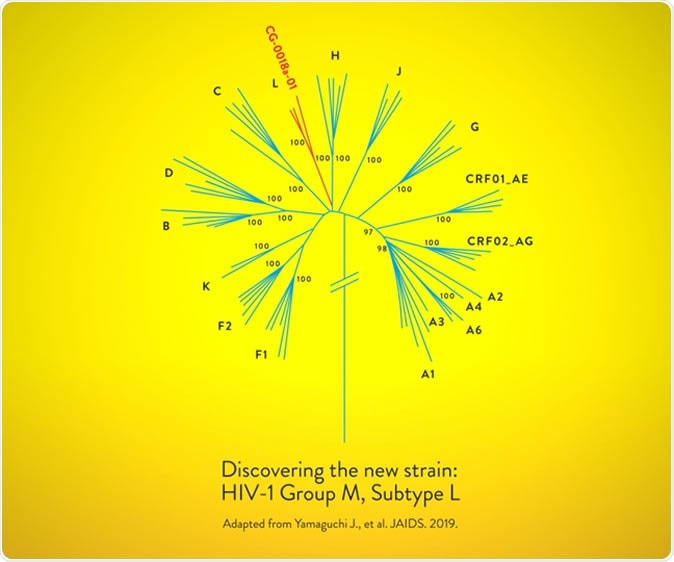Researchers have for the first time in nearly twenty years come upon a new strain of HIV or Human Immunodeficiency Virus. This strain is a part of the Group M type of HIV-1. HIV-1 is the causative agent of worldwide HIV infections. The study from the University of Missouri, Kansas City with assistance from Abbott Laboratories was titled, “Complete genome sequence of CG-0018a-01 establishes HIV-1 subtype L,” and the results were published in the latest issue of Journal of Acquired Immune Deficiency Syndromes this week.

The team of researchers Julie Yamaguchi, as first author, explained that HIV has different strains and subtypes that can change by mutation with time. Subtype identification guidelines were established in 2000 said the researchers. Since then, this is the first time that a Group M HIV strain has been identified.
According to the UNAIDS there have been 1.8 million new cases of HIV infection in 2016 and at present 36.7 million people are living with HIV says the World Health Organization (WHO).
Dr. Anthony Fauci, director of the National Institute of Allergy and Infectious Diseases, assured that the present drugs that are active against HIV are capable of fighting this new strain of HIV as well. He added that knowing the new strains can help develop a map of evolution of HIV over time. Fauci said, “There's no reason to panic or even to worry about it a little bit. Not a lot of people are infected with this. This is an outlier.”
This is important research because it helps researchers identify the circulating strains of the virus say the authors of the study. Mary Rodgers, a co-author of the report and head of Global Viral Surveillance Program at Abbott, in her statement said, “It can be a real challenge for diagnostic tests.” She explained that the labs need to test blood samples across the world and Abbott alone tests around 60 percent of the world’s blood supply. For such massive numbers of testing the units need to be able to identify the new strains correctly. She said that this study means that now “we can accurately detect it, no matter where it happens to be in the world.”
Discovery of a New Strain of HIV
In 2000 the guidelines for identification of a new strain of HIV were outlined. One of the requisites to pinpoint a new strain was that three cases of the virus infection would have to be identified independently in different geographic locations. The team said that two cases of this strain of infection were detected in 1983 and 1990 in the Democratic Republic of Congo. Rodgers explained that these two cases were unusual and “didn't match other strains”. Then the researchers confirmed a third case of this virus strain infection in Congo in 2001.
At the time of collection of a blood sample that showed up this new strain genomics was not as developed as now. The third sample was from a small study that was looking at mother to foetus transfer of the infection. They called it the specimen or sample CG-0018a-01. In this new study the team could map out the whole genome of the new strain and confirm the existence of the new subtype. Rodgers said looking for the small difference in the strain of HIV was much like looking for a “needle in a haystack”. What Abbott and University of Missouri managed to do with their new technology was to develop a “magnet” that could pull the needle form the haystack, she explained. The team wrote, “Metagenomic (mNGS) and HIV-specific target enriched (HIV-xGen) libraries were combined for next generation sequencing (NGS) to extend genome coverage.”
On mapping out the complete genome of the new strain the team was able to identify the subtype as subtype L of Group M. At present the exact effects of this strain of the virus on humans is unknown, they wrote. In fact the team was not sure if the new strain behaved any differently within the body from other HIV strains.
The authors wrote in conclusion, “The CG-0018a-01 HIV-1 genome establishes subtype L and confirms ongoing transmission in DRC as recently as 2001. Since CG-0018a-01 is more closely related to an ancestral strain than to isolates from 1983 or 1990, additional strains are likely circulating in DRC and possibly elsewhere.”
Dr. Carole McArthur, Professor in the department of oral and craniofacial sciences at the University of Missouri, Kansas City and one of the study researchers said, “This discovery reminds us that to end the HIV pandemic, we must continue to out think this continuously changing virus and use the latest advancements in technology and resources to monitor its evolution.”
“The primary concern is that HIV might evolve to the extent that testing wouldn’t work,” said Rodgers. She added, “We definitely don’t work in isolation. We’re sharing this strain with the scientific community so others can work on the strain and hopefully that can advance things like vaccines and treatments.” She said, “We’re not going to slow down. We can never become complacent, we need to be proactive and we’re working to stay a step ahead of the virus. To prevent new infections, we have to understand how they have spread in the past.”
Sources:
Journal reference:
Complete genome sequence of CG-0018a-01 establishes HIV-1 subtype L, Yamaguchi, Julie BS; McArthur, Carole MD; Vallari, Ana MS; Sthreshley, Larry PhD; Cloherty, Gavin A. PhD; Berg, Michael G. PhD; Rodgers, Mary A. PhD, https://journals.lww.com/jaids/Fulltext/publishahead/Complete_genome_sequence_of_CG_0018a_01.96307.aspx